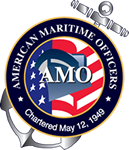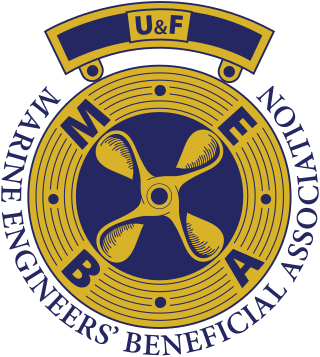
New York Harbor is at the mouth of the Hudson River where it empties into New York Bay near the East River tidal estuary, and then into the Atlantic Ocean on the United States East coast.

The United States Merchant Marine is composed of United States civilian mariners and U.S. civilian and federally owned merchant vessels. Both the civilian mariners and the merchant vessels are managed by a combination of the government and private sectors, and engage in commerce or transportation of goods and services in and out of the navigable waters of the United States. The Merchant Marine primarily transports domestic and international cargo and passengers during peacetime, and operate and maintain deep-sea merchant ships, tugboats, towboats, ferries, dredges, excursion vessels, charter boats and other waterborne craft on the oceans, the Great Lakes, rivers, canals, harbors, and other waterways. In times of war, the Merchant Marine can be an auxiliary to the United States Navy, and can be called upon to deliver military personnel and materiel for the military.

The Seafarers International Union or SIU is an organization of 12 autonomous labor unions of mariners, fishermen and boatmen working aboard vessels flagged in the United States or Canada. Michael Sacco was its president from 1988 until 2023. The organization has an estimated 35,498 members and is the largest maritime labor organization in the United States. Organizers founded the union on October 14, 1938. The Seafarers International Union arose from a charter issued to the Sailors Union of the Pacific by the American Federation of Labor as a foil against loss of jobs to the Congress of Industrial Organizations (CIO) and its Communist Party-aligned faction.

Joseph Curran was a merchant seaman and an American labor leader. He was founding president of the National Maritime Union from 1937 to 1973, and a vice president of the Congress of Industrial Organizations (CIO).

A maritime pilot, marine pilot, harbor pilot, port pilot, ship pilot, or simply pilot, is a mariner who has specific knowledge of an often dangerous or congested waterway, such as harbors or river mouths. Maritime pilots know local details such as depth, currents, and hazards. They board and temporarily join the crew to safely guide the ship's passage, so they must also have expertise in handling ships of all types and sizes. Obtaining the title "maritime pilot" requires being licensed or authorised by a recognised pilotage authority.

A sea captain, ship's captain, captain, master, or shipmaster, is a high-grade licensed mariner who holds ultimate command and responsibility of a merchant vessel. The captain is responsible for the safe and efficient operation of the ship, including its seaworthiness, safety and security, cargo operations, navigation, crew management, and legal compliance, and for the persons and cargo on board.

A wiper is a position responsible for both cleaning the engine spaces and machinery of a ship and assisting the ship's engineers as directed. Railroad workers who performed similar jobs were also known as wipers, or in the UK as "cleaners".

American Maritime Officers (AMO) is a national labor union affiliated with the Seafarers International Union of North America. With an active membership of approximately 4,000, AMO represents licensed mariners working in the United States Merchant Marine aboard U.S.-flagged merchant and military sealift vessels. AMO holds a unique presence in the international energy transportation trades.
Shannon J. Wall was a merchant seaman and an American labor leader. He was president of the National Maritime Union from 1973 to 1990. His father and mother ran a small dry cleaning company.
The National Maritime Union (NMU) was an American labor union founded in May 1937. It affiliated with the Congress of Industrial Organizations (CIO) in July 1937. After a failed merger with a different maritime group in 1988, the union merged with the Seafarers International Union of North America in 2001.
The Maritime Trades Department, AFL–CIO (MTD) is one of seven constitutionally-mandated departments of the AFL–CIO. Formed on August 19, 1946, by the American Federation of Labor, the stated goal of the department is to give "workers employed in the maritime industry and its allied trades a voice in shaping national policy."

A licensed mariner is a sailor who holds a license from a maritime authority to hold senior officer-level positions aboard ships, boats, and similar vessels. Qualification standards for licensed mariners are universally set by the STCW Convention adopted and promulgated by the International Maritime Organization (IMO), while the licenses of individual sailors are issued by the delegated maritime authorities of the member states of the IMO; these may vary in the details of the implementation, including the government agency responsible for licensing and the local names of the grades and qualifications in each particular country.
The International Seamen's Union (ISU) was an American maritime trade union which operated from 1892 until 1937. In its last few years, the union effectively split into the National Maritime Union and Seafarer's International Union.
The maritime history of the United States is a broad theme within the history of the United States. As an academic subject, it crosses the boundaries of standard disciplines, focusing on understanding the United States' relationship with the oceans, seas, and major waterways of the globe. The focus is on merchant shipping, and the financing and manning of the ships. A merchant marine owned at home is not essential to an extensive foreign commerce. In fact, it may be cheaper to hire other nations to handle the carrying trade than to participate in it directly. On the other hand, there are certain advantages, particularly during time of war, which may warrant an aggressive government encouragement to the maintenance of a merchant marine.

The Marine Engineers' Beneficial Association (MEBA) is the oldest maritime trade union in the United States still currently in existence, established in 1875. MEBA primarily represents licensed mariners, especially deck and engine officers working in the United States Merchant Marine aboard US-flagged vessels. It is a member union of the AFL–CIO.
The maritime history of the United States (1800–1899) saw an expansion of naval activity.
The United States merchant marine forces matured during the maritime history of the United States (1900–1999).

Panama Pacific Line was a subsidiary of International Mercantile Marine (IMM) established to carry passengers and freight between the US East and West Coasts via the Panama Canal.
A master mariner is a licensed mariner who holds the highest grade of seafarer qualification; namely, an unlimited master's license. Such a license is labelled unlimited because it has no limits on the tonnage, power, or geographic location of the vessel that the holder of the license is allowed to serve upon. A master mariner would therefore be allowed to serve as the master of a merchant ship of any size, of any type, operating anywhere in the world, and it reflects the highest level of professional qualification amongst mariners and deck officers.

A sailor, seaman, mariner, or seafarer is a person who works aboard a watercraft as part of its crew, and may work in any one of a number of different fields that are related to the operation and maintenance of a ship.











